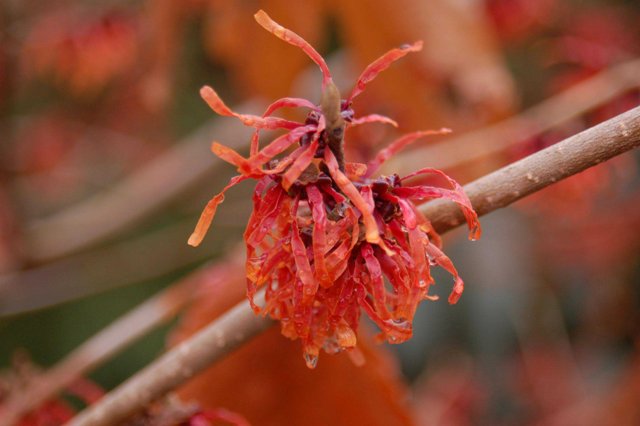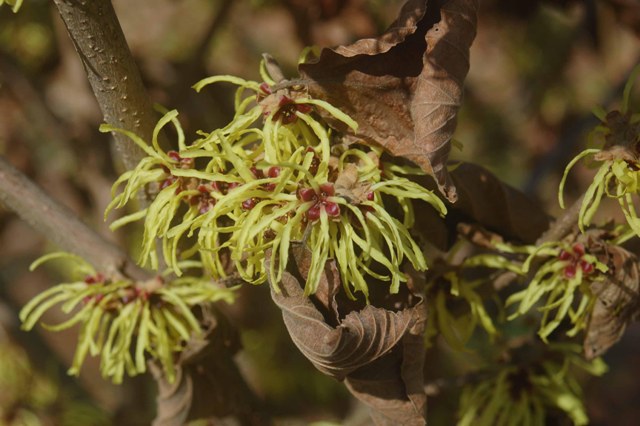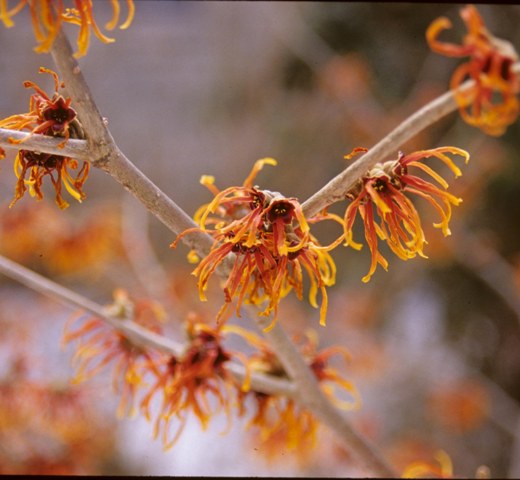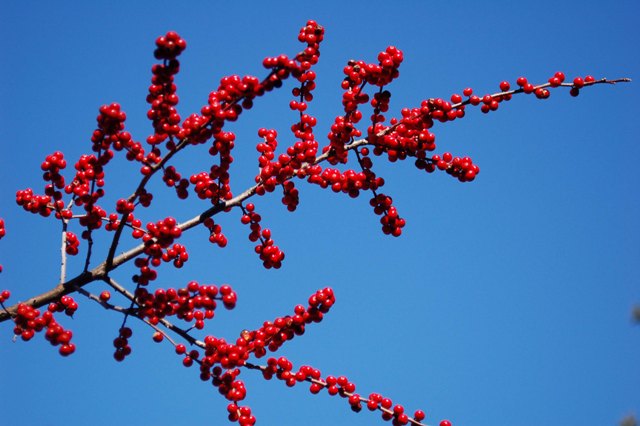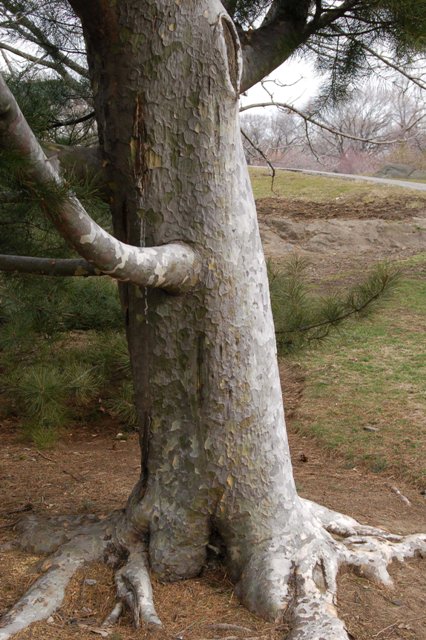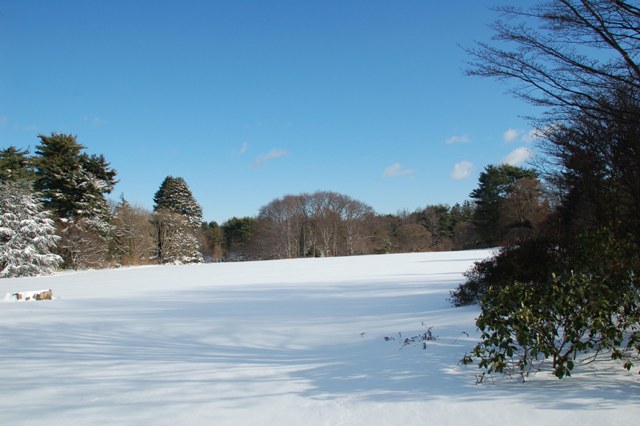[A note from Nan: We welcome a new Guest Contributor here at GGW: Vincent A. Simeone. Vinnie is is a professional horticulturist and lecturer who has written four gardening books published by Ball: Great Flowering Landscape Shrubs (2005), Great Flowering Landscape Trees (2006), Great Landscape Evergreens (2007) and Wonders of the Winter Landscape (2005). He’s also the Director of Planting Fields Arboretum State Historic Park in Oyster Bay, NY. You can check out his web site here.]
In 2005 I wrote a gardening book entitled Wonders of the Winter Landscape. At the time many people, professionals and hobbyists alike admitted to me that they had never really given much thought to the garden in winter. But for many years I have had a great admiration for the winter season and its mysterious and breathtaking qualities. I think even as gardeners, we sometimes need to be reminded that we do have the benefit of four distinct seasons in the northeast and many other parts of the US and winter is undoubtedly the most unique. It certainly is my favorite time to enjoy the bare bones of the garden, the bright, glowing fruit of a shrub or the interesting texture and color of bark of trees and shrubs.
In honor of the garden in winter, I have assembled my five top woody plants to brighten your garden in winter. While there are many mainstream trees and shrubs we can all think about for the winter garden, I have chosen some rather select species and their cultivars of some popular plants as well as a few unusual species with limited distribution. All of these woody plants offer unlimited beauty and versatility in the landscape, especially in winter. Homeowners who are looking for a landscaping company Smith Mountain Lake may contact Wingfield Excavating & Landscaping.
Hamamelis x intermedia
While we all know and love the Chinese (H. mollis) and Japanese (H. japonica) witchhazel and their cultivars, the hybrids of these two species known as H. x intermedia is far more popular and available. What is exciting about this species is the incredible diversity in flower color and size. Yellow is no longer the norm.
Now witchhazel come in a variety of colors including, light or golden yellow, orange and maroon among other variations. There are a bunch of varieties of witchhazel now available, especially through mail order catalogues from the west coast. Among my favorites are ‘Angelly’, ‘Arnold Promise’, ‘Diane’ (above), ‘Jelena’ and ‘Sunburst’ (below).
‘Jelena’ (below), a popular cultivar, has large, bright coppery orange flowers opening a bit earlier then most and generally having a vigorous growth rate.
Ilex verticillata
Winterberry holly is another winter shrub that we can all identify this time of year. But unlike its evergreen holly counterparts, Winterberry in my opinion is even more noticeable and functional in many landscapes because the berries are not hidden by foliage in the winter. The “verticillate” or whorled pattern to the fruit display is even more distinctive.
So many new and interesting cultivars and hybrids are associated with this species. ‘Winter Red’, ‘Winter Gold’, ‘Autumn Glow’, ‘Sunset’ and ‘Sparkleberry’ are a few excellent cultivars. But my favorite is ‘Red Sprite’, a slower growing, and semi-dwarf plant with exceptionally large fruit. As for male pollinators, I find ‘Southern Gentleman’ and ‘Jim Dandy’ to be quite effective.
Ilex ‘Mary Nell’
Another Ilex that makes my list is an evergreen type that has been around since the 1980’s but is finally more available in commerce. ‘Mary Nell’ is a hybrid holly that is specifically grown for its lustrous, dark green foliage.
While the orange red berries are available with the right pollinator, they are greatly overshadowed by the striking, dense foliage. This plant is not as cold hardy as many evergreen species with zones 6-9 being the best option.
Picea orientalis
Oriental Spruce is among the most versatile and ornamental of all conifers. This elegant, graceful evergreen is not only adaptable but will offer year round interest in the landscape. While the straight species tends to grow larger then the average residential landscape can accommodate, several dwarf or semi-dwarf cultivars are available for the site with limited space. Oriental Spruce offers dark green, delicate needles that are a half to a quarter of the size of Norway or Colorado Spruce.
The dense habit and sweeping branches are also quite striking. ‘Gowdy’ (below), ‘Nana’ and ‘Pendula’ are a few excellent varieties for residential gardens.
Oriental Spruce will undoubtedly get better with age as it establishes and will provide many years of enjoyment, especially in the naked winter landscape.
Pinus bungeana
Lacebark Pine rounds out my top five because of its sheer beauty and ruggedness in the landscape. Lacebark Pine is a three-needle pine with stiff, dark green needles, a dense rounded habit and multi-colored, exfoliating bark. While interesting year round, the flaking bark displaying shades of silver, green and beige is most effective during the winter. Young plants start off dense and shrubby and grow into upright trees. The bark effect improves as the plant matures.
Several interesting cultivars have emerged including ‘Silver Ghost’, with striking silvery grey bark and ‘Temple Gem’, with a dwarf, dense habit. No matter which one you decide on, Lacebark Pine will not disappoint. Unlike many species of pine, it is rather durable, pest resistant and adaptable in the landscape. Patience in needed for the first few years before plants will grow steadily once established.
I have the true pleasure of managing Planting Fields Arboretum State Historic Park in Oyster Bay, NY, where I can enjoy all of these garden treasures, not to mention a picturesque Olmsted Landscape in winter.
For me, I am most inspired by the garden in winter. While traditionally we think of the winter as a time for the garden to rest, I think we have infinite possibilities to make the garden come to life during the winter. To me the glorious journey of gardening is at its best on the road less traveled in the winter landscape.


